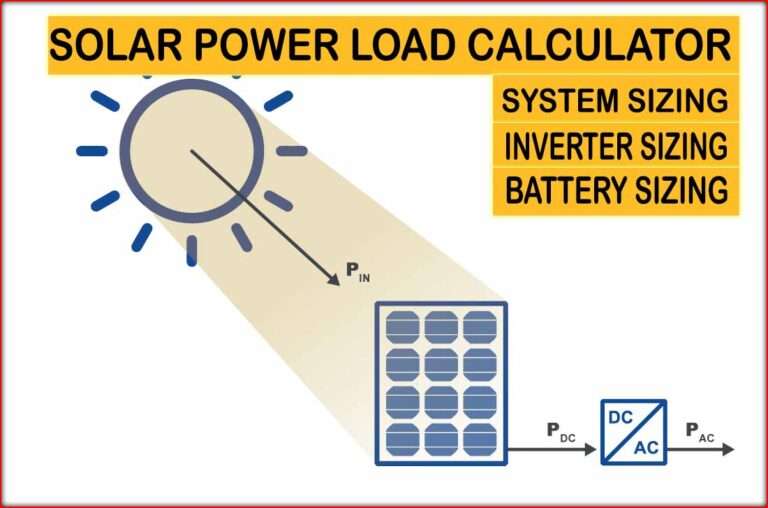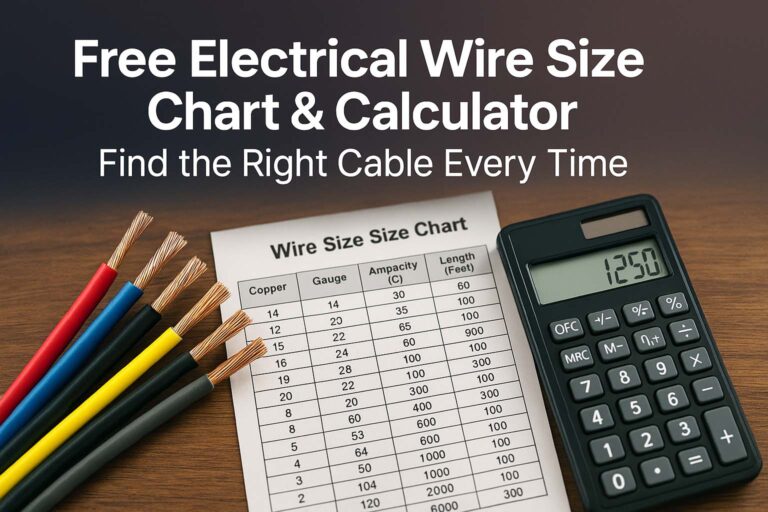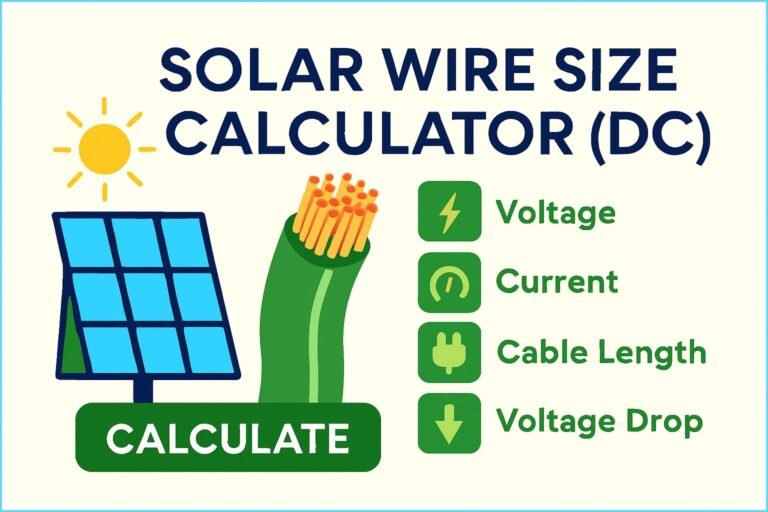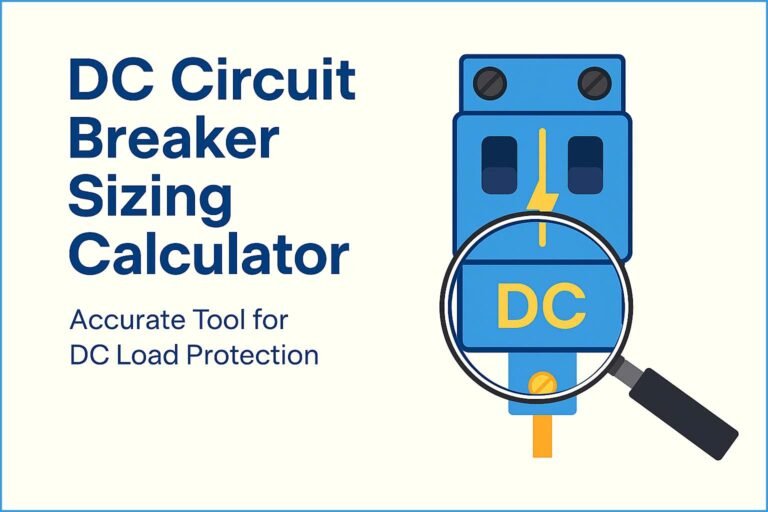What Gauge Wire Do I Need? Free Online Calculator for Electricians & Homeowners
Choosing the correct wire gauge is essential for safe and efficient electrical systems. Whether you’re an electrician wiring a commercial space or a homeowner installing a new outlet, understanding what gauge wire you need can protect your devices and prevent electrical fires. With our free wire gauge calculator, you can make quick, reliable decisions backed by NEC standards and best practices.
Table of Contents
Table of Contents

In this guide, we’ll explore wire gauge basics, technical insights, and how to use an electric wire gauge chart to determine the correct wire size for your project. Plus, you’ll learn how our online calculator simplifies the process.
Understanding What Gauge Wire Means
In electrical terms, wire gauge refers to the thickness or diameter of a conductor. The most common measurement system used in the U.S. is AWG – American Wire Gauge. In AWG, the lower the number, the thicker the wire. For example, a 10 AWG wire is thicker than a 14 AWG wire. Thicker wires carry more current and can travel longer distances with less voltage drop.
Why Choosing the Right Wire Gauge Matters
Using the wrong wire gauge can lead to serious safety issues:
- Overheating: Undersized wires heat up under load, risking insulation damage or fire.
- Voltage Drop: Thin wires over long distances cause voltage loss, affecting appliance performance.
- Breaker Trips: If the wire isn’t rated for the current, your breaker may trip frequently.
That’s why electricians always consult electric wire gauge charts or use a wire gauge calculator before starting work.
Use our online tool NEC Wire Size Calculator – Voltage Drop Compliant Sizing for 120V & 240V Circuits
Wire Gauge Calculator – A Simple Tool to Avoid Guesswork
Our free wire gauge calculator removes the complexity. Instead of flipping through charts or doing manual voltage drop calculations, just input:
- Load in amps
- Voltage (120V, 240V, etc.)
- Distance (one-way or round trip)
- Phase (single-phase or three-phase)
The calculator instantly provides the recommended wire gauge that complies with NEC voltage drop standards (less than 3% drop).
Use the wire gauge calculator for:
- Home wiring projects
- Solar panel installations
- EV charger setups
- HVAC and motor loads
- Long-distance lighting
Try the calculator online now to avoid oversizing or undersizing your wires.
Electric Wire Gauge Chart – Quick Reference for Electricians
Below is a simplified electric wire gauge chart based on copper conductors at 75°C insulation. This can be used for general applications in residential or light commercial settings.
| AWG Size | Ampacity (Amps) | Common Usage |
|---|---|---|
| 18 AWG | 10 | Low voltage lighting, alarms |
| 16 AWG | 13 | Small appliances |
| 14 AWG | 15 | Lighting circuits (120V) |
| 12 AWG | 20 | General outlets (120V) |
| 10 AWG | 30 | Water heaters, AC units |
| 8 AWG | 40–55 | Electric ovens, dryers |
| 6 AWG | 55–65 | Range, heavy appliances |
| 4 AWG | 70–85 | Subpanels, large circuits |
| 2 AWG | 95–115 | Feeders, service entrance |
| 1/0 AWG | 150 | Large feeders, main panels |
| 3/0 AWG | 200 | Commercial applications |
Note: Always consult NEC tables or a licensed electrician for final sizing based on insulation type, temperature rating, and installation method.
Use our online tool Wire Size Calculator by Load and Length – Accurate Amp Sizing for Home Wiring
How Distance Affects Wire Size – Voltage Drop Explained
Many DIYers forget that distance impacts wire sizing. Even if your wire is thick enough for the current, voltage can drop over long runs. This is critical for outdoor lighting, shed wiring, or well pump installations.
Let’s say you’re powering a 15A device 100 feet away. A 14 AWG wire may be rated for 15A, but the voltage drop could exceed 5%, causing dim lights or equipment failure. Instead, a 12 AWG or 10 AWG wire would reduce voltage drop to acceptable levels.
Voltage Drop Formula (Simplified)
Voltage Drop (V) = (2 × Length × Current × Resistance per 1000 ft) / 1000
It’s a technical calculation, but you don’t need to memorize it. Use the wire gauge calculator to handle these inputs automatically.
What Gauge Wire for Different Applications?
Let’s look at real-world scenarios where wire gauge selection is essential.
Home Electrical Circuits
- Lighting Circuits – Use 14 AWG for 15-amp breakers
- Power Outlets – Use 12 AWG for 20-amp breakers
- Kitchen Appliances – Use 10 AWG for high-demand devices
- Air Conditioners – Use 10 or 8 AWG based on BTUs and load
Solar Systems
- DC String Wires – Usually 10 AWG or 8 AWG
- Battery Bank to Inverter – Use 4 AWG or thicker depending on current
- AC Output from Inverter – Match the load demand, usually 10 AWG or thicker
EV Chargers
- Level 2 Chargers (32A–50A) – Use 6 AWG or 4 AWG wire
- Long Distances (50+ ft) – May need to size up to prevent voltage drop
Use our online tool Solar System Sizing Calculator for Agriculture & Tubewells
Aluminum vs. Copper Wire – Does It Change the Gauge?
Yes. Aluminum wire has lower conductivity than copper. You need a thicker aluminum wire to carry the same current. If your project uses aluminum, size up at least 2 AWG sizes compared to copper.
For example:
- 4 AWG copper = 2 AWG aluminum
- 2 AWG copper = 1/0 aluminum
Always check if your terminals are rated for aluminum and use anti-oxidant compound at joints.
How to Use Our Wire Gauge Calculator – Step-by-Step
Here’s how you can calculate the right gauge in under 30 seconds:
- Enter Load Amps – E.g., 20 amps for a water heater
- Enter Voltage – Usually 120V or 240V
- Enter Distance – One-way or round-trip, in feet
- Select Phase – Single-phase for homes, three-phase for industry
- Click Calculate – Get the recommended wire gauge instantly
The result is based on standard copper wire, 75°C insulation, and NEC voltage drop limits. Adjustments can be made for aluminum or high-temperature wires.
Tips for Electricians and DIYers
- Always round up: If in doubt between two sizes, choose the thicker wire
- Check insulation rating: THHN, XHHW, and UF have different ampacities
- Avoid splices: Use continuous runs where possible to reduce resistance
- Use conduit or cable trays: Protect wires from mechanical damage
- Follow local codes: NEC is standard, but local rules may vary
Common Questions About What Gauge Wire You Need
Q: Can I use 14 AWG wire on a 20 amp breaker?
A: No. NEC requires 12 AWG minimum for 20 amp circuits to avoid overheating.
Q: What wire gauge should I use for a 100-foot run?
A: It depends on the load. Use the calculator to factor in distance and current.
Use our online tool Backup Generator Sizing Calculator
Q: How do I size wire for a motor?
A: Motors have special requirements. Use the full load current (FLC) from NEC tables, then factor in startup currents. Generally, you’ll oversize the wire slightly.
Q: Is it okay to oversize the wire?
A: Yes. Oversizing reduces voltage drop and heat loss. It’s only a problem if your conduits get overfilled.
Final Thoughts – Let the Wire Gauge Calculator Do the Work
Choosing the correct wire size doesn’t have to be difficult. Understanding what gauge wire is needed for your project is essential for safety, efficiency, and compliance. Whether you’re working on a solar system, a kitchen remodel, or an outdoor shed, our wire gauge calculator provides the answers in seconds.
Use our online tool 3 Phase Motor Cable Size Calculator: A Comprehensive Guide
Stop second-guessing your wire sizes. Use the calculator and electric wire gauge chart to ensure every circuit is built right the first time. Electricians and homeowners alike trust tools like this to save time, reduce errors, and pass inspections without hassle.
Use the Free Wire Gauge Calculator now and wire smarter, safer, and more confidently.
Follow Us on Social:
Subscribe our Newsletter on Electrical Insights for latest updates from Electrical Engineering Hub
#wiregaugecalculator, #whatgaugewire, #electricwiregaugechart, #wiregauge, #electricalcalculator, #homewiring, #electriciansguide, #diyelectrical, #wiresizing, #ampsizing, #cablecalculator, #electricalsafety, #residentialwiring, #loadcalculation, #electricaltools






